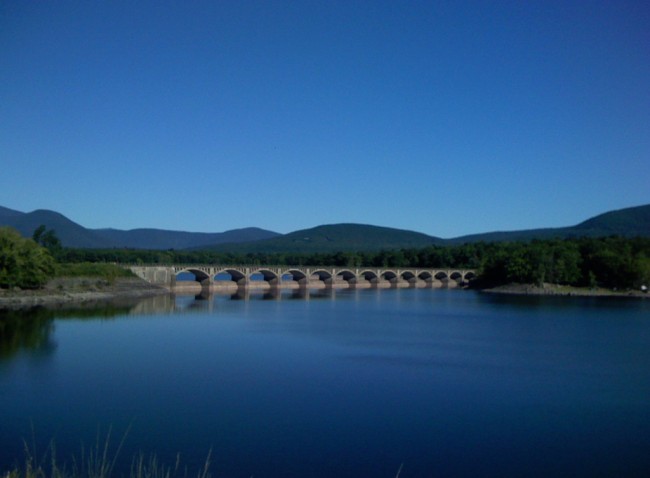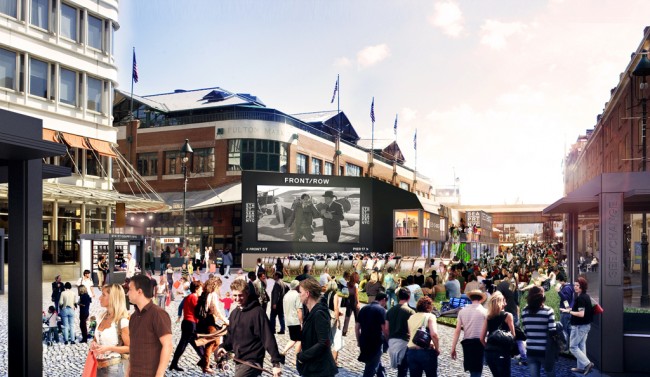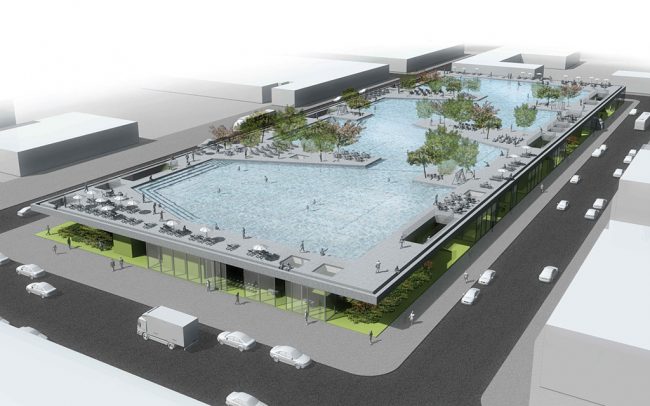
We are celebrating 15 years — and counting — of stories that are deeply researched and deeply felt, that build a historical record of what the city has been.
We are celebrating 15 years — and counting — of stories that are deeply researched and deeply felt, that build a historical record of what the city has been.

The Ashokan Reservoir in the Catskills, a source of NYC drinking water | Image via Angelaelle
THE PAST AND FUTURE OF NYC’S WATER
The infrastructure that provides one billion gallons of fresh drinking water to eight million people in New York City every day stretches across 125 miles and represents one of the largest predominantly unfiltered municipal water supply systems in the world. The construction of the system required political maneuvering of an equally enormous scale, the destruction of towns, and flooding of thousands of acres, and the City must continually face new challenges in maintaining the system, from regulatory changes to the specter of fracking upstate. In a two-part interview with Gotham Gazette, historian David Soll, author of Empire of Water, recounts the history of the city’s water supply and the contemporary efforts to retain the purity and access to water we take for granted.
WORLD TRADE CENTER SECURITY PLANS
With One World Trade Center’s face to the world nearing completion, the NYPD released its plans for security at ground level this week, composed of a protective boundary of guard booths and road and sidewalk barriers. These barriers threaten the vision laid out for Lower Manhattan following 9/11, which sought to reintegrate the new center with downtown by reestablishing the street connections previously wiped away by the superblock that housed the twin towers. Under the plan, pedestrians and cyclists would be allowed free movement along the streets running through the complex, though car traffic would be restricted to vehicles with business at the Center through a series of inspection points. While the NYPD claims the measures will not dampen the street life needed to prevent the isolation of the site, many public officials and community members alike fear that businesses and people will shy away from the heavy security presence.

SEE/CHANGE’s soon to be rolled-out lawn and movie screen | Image via Howard Hughes
SEE/CHANGE AT THE SEAPORT
In a bid to bring life back to the South Street Seaport while many of its ground-level shops remain shuttered after Sandy, a partnership among the Seaport’s developers, the Howard Hughes Corporation, the City, and special-events organizers are launching “See/Change,” a summer redesign of the area that will include the installation of stores made from shipping containers, a stage for concerts and film screenings, and stands for artisanal food vendors. This temporary tweak of the Seaport will precede larger redevelopment in the area, with Pier 17 soon to house a new retail complex and the old Fulton Fish Market and a neighboring building set to become home to two public food markets. The size of the space offered in the development plan, however, disappointed advocates for a public market on the site, among them Robert LaValva, who shared his vision of the market with us last summer. LaValva’s bustling New Amsterdam Market, which currently brings many artisanal food vendors to the Fulton Fish Market it currently calls home, is now in its last season on the site, soon to be pushed out by the impending development.
A (SOMEWHAT) CLEANER CANAL
The Bloomberg administration announced this week that the activation of a new pumping station by the end of the year will reduce sewage overflow into the Gowanus Canal by 34%. Coupled with improvements to a flushing tunnel, closed since 2010, that pushes water from the bay through the canal, the station’s opening will mark the completion of the City’s $190 million effort to make the Superfund site a bit cleaner. The EPA team behind the separate Superfund cleanup plans has proposed the construction of two underground holding tanks for sewage that would otherwise flow into the canal, which has garnered local opposition due to their proposed siting beneath a public pool and park. The City, which would be on the hook to build the tanks, opposes their construction, part of ongoing wrangling between the administration and the EPA.
THE PATH HUB: A HISTORY OF SETBACKS
At nearly $4 billion, the PATH Transportation Hub at the World Trade Center complex is set to be the world’s most expensive train station when it opens in two years, if a timeline that has suffered more delays than any other project on the troubled construction site holds true. The New York Observer charts the history of its construction, replete with cost overruns and changing administrations, and considers whether the unprecedented cost is worth the tradeoff in stalling other Port Authority projects vital to the region’s transportation infrastructure.
LITTLE BOXES ON THE COASTLINE
The Department of Housing Preservation and Development issued a request for qualifications last week seeking developers to create plans for rebuilding one- to four-family homes in six areas of the city affected by Hurricane Sandy. Once in place, residents will be able to opt into the program and select from two to four different shapes and sizes of homes designed by the developers. The City touts the benefits of streamlining the design process, relying on a pre-selected group of six architect, developer, and contractor teams to navigate new building and zoning codes put in place following the storm. The program aims to rebuild 400 to 750 properties, consistent with existing neighborhood fabric, with part of the $350 million in Sandy aid earmarked for repair of smaller properties.

Flood Courts Gowanus, the winner in the Community Programming Category | Image via Gowanus by Design
EVENTS AND STUFF TO DO
WATER_WORKS COMPETITION EXHIBIT
In anticipation of the construction of the sewage holding tanks along the Gowanus Canal noted above, Gowanus by Design, a community-based urban design advocacy group, held its second annual design competition — Water_Works — to solicit ideas for how a new community resource could be built around this infrastructure aimed at reducing combined sewage overflows into the canal. (The team at Gowanus by Design shared the winners of their inaugural competition with us in this 2011 feature.) An exhibition of winning entries will be on display at the Old American Can Factory Gallery beginning May 22nd with an opening from 6:30 to 9pm.
UNIONDOCS COLLABORATIVE STUDIO
Applications are open for the UnionDocs Collaborative Studio (CoLAB), a 10-month program for a select group of media artists from the US and abroad. Based in Williamsburg, CoLAB offers a platform for exploring contemporary approaches to the documentary arts and a process for developing an innovative collaborative project. UnionDocs screenings, live programs, and CoLAB productions consistently offer sophisticated reflection on place-based explorations of urban dynamics, several of which we’ve reported on in the past. Apply to be a part of the program today.
PUBLIC ACCESS DESIGN WITH CUP
Our friends at the Center for Urban Pedagogy (CUP) are soliciting applications from NYC-based designers interested in creating playful solutions to the challenges of design for social change to join its Public Access Design program as 2013-2014 Design Fellows. Fellows will work collaboratively with CUP and community organizations to create accessible visual tools on a complex policy or planning issue. The deadline for applications, which can be found here, is June 10th.
MAPPING COASTAL MEMORIES
WNYC invites you to add to its map of beach memories — from childhood to before Sandy — as part of its Life After Sandy series. Wade through others’ memories and add your own here.
SANDY: READY FOR THE NEXT ONE?
Join the City University of New York for a symposium on lessons learned from Sandy and the city’s readiness for the next storm on May 29th. The three sessions, running from 9am to 1pm, are free and open to the public.
The Roundup keeps you up to date with topics we’ve featured and other things we think are worth knowing about.
The views expressed here are those of the authors only and do not reflect the position of The Architectural League of New York.